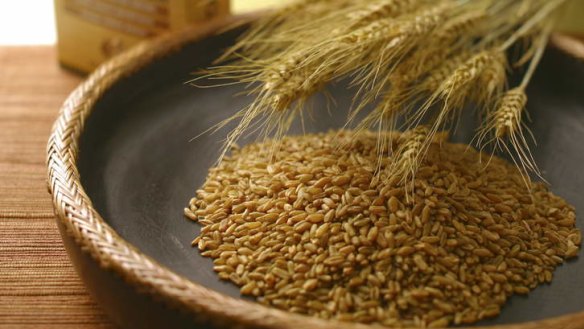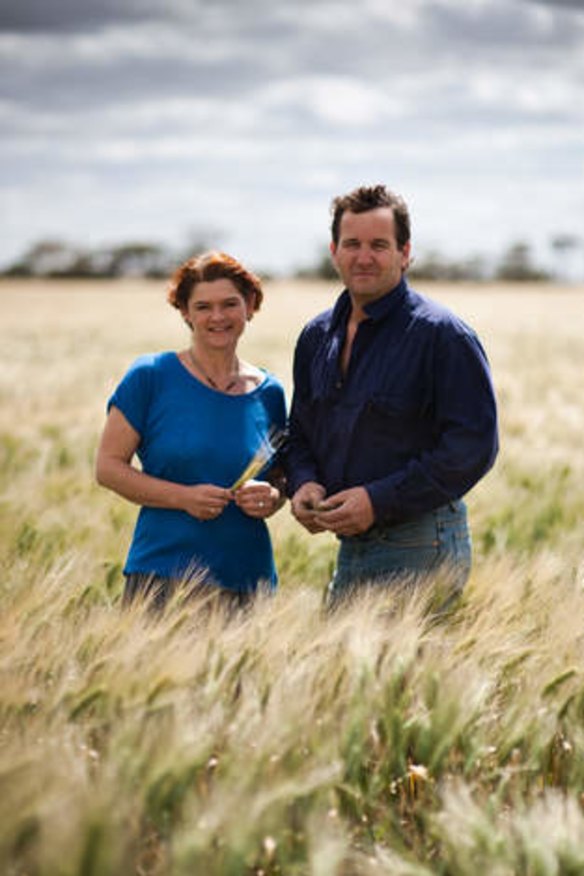Freek out with freekeh
Roasted green wheat from the Middle East is being hailed as a superfood, and a grain worth growing.

Out among the waving fields of barley destined for breweries around the nation, South Australian grain farmer Elden Oster is growing a crop that is being hailed as a Middle Eastern superfood. With the global food industry scouring the planet for ancient grains suitable to be labelled healthy and nutritious, the spotlight has now focused on the traditional Middle Eastern method of roasting young wheat. The end product is known as freekeh.
Oster holds an ear of green wheat in his hand and peels away the coarse outer layers to reveal soft pale-green grains.
"This is durum wheat," says Oster, whose farm is on the Yorke Peninsula, 90 minutes north-west of Adelaide. He squeezes a grain and out pops its still-milky insides. "Normally we let the wheat ripen and harden before harvest," he says. "But this is going to be harvested beautifully soft and green and roasted to make freekeh."

Freekeh was traditionally a method of harvesting and preserving green wheat. The foundation myth of freekeh tells a story of a nation state in what is now the Jabal 'Amel region of Lebanon about to come under attack around 2300BC. Fearing they would lose their wheat crop, they harvested it green. The city was burned, the people survived but found their harvest scorched. They reclaimed what they could and found it wholesome and delicious.
Today, in countries such as Syria, Lebanon, Jordan and Egypt, green wheat stalks are harvested around April and May, about 42 days before the main wheat crop is ripe. The green wheat is gathered in bunches and dried in the sun for a day before it is roasted over a fire. The chaff and straw burn away and the wheat takes on a gold to dusky coral red colour. The local shrubs burned determine its flavour.
The word freekeh has its roots in an Arabic word, faraka, meaning to rub, which refers to the traditional method of rubbing the husk away from the dried wheat. The wheat is left to dry further and cracked or left whole.
Many years ago, when I was working in the outer Melbourne suburb of St Albans, I would buy groceries from an Egyptian grocer. When I asked him how I should cook freekeh, he bustled behind a curtain that separated the store from his living room and out came his wife. She said it was delicious cooked in chicken stock and served like rice with slow-cooked meat dishes. She also suggested stuffing a little cooked freekeh into quail before grilling them over the coals of a barbecue, during which time the grains would absorb the cooking juices of the quail. The most important recipe she handed over, perhaps hoping I would buy the larger of the two bags of freekeh on sale, was a stunning recipe for chicken and freekeh soup spiced with cinnamon and garlic.
The UN Food and Agriculture Organisation recognises freekeh as an important food source in the Middle East, where its production is threatened by changing lifestyle and ongoing civil unrest. Which is why the production of freekeh in Australia is important as it creates supply for growing global demand.
The wheat Oster grows in South Australia's barley belt - sold under the Goodness Superfoods label - is not roasted over a fire but instead heated in ovens, drying out and hardening the grains. During this process the wheat darkens and takes on a lovely nutty flavour. Cooking is simple. Half a cup of freekeh is brought to the boil in two cups of boiling water. Once boiling, the heat is lowered, the saucepan covered and the grains cooked for 20 to 25 minutes. During cooking the grains rehydrate and take on a wonderfully chewy texture.
Sydney nutritionist and dietitian Dr Joanna McMillan is a big fan of freekeh.
"It's high in fibre, higher in protein and several micronutrients than other grains, and it's low GI," she says. "That means you absorb the carbs slowly so the impact on blood sugar levels is less, energy is more sustained and it helps control your hunger."
She recommends using freekeh with a combination of other healthy foods to maximise its nutritional potential.
"I teach a plate model approach," McMillan says. "Start with half the plate vegies, a quarter of the plate protein, such as meat, fish, tofu or beans, a dash of healthy fat and the remainder a low GI carbohydrate such as freekeh."
In the Osters' dining room, I sit down to a meal with Elden and wife Julie. They gave up the traditional farmer's meat-and-three-veg diet a long while back and are enjoying a healthy meal of freekeh and chickpeas, grown on their farm. So good is the recipe,
it has been shortlisted as a state finalist in Australia's best home-cooked dish competition at May's Noosa Food and Wine Festival.
Freekeh and chickpea salad with pomegranates
1 pomegranate
2 tbsp extra virgin olive oil
salt to taste
½ tsp thyme leaves
1 cup cooked freekeh
1 cup cooked chickpeas
small handful Italian parsley, coarsely chopped
125ml sheep’s milk yoghurt
extra-virgin olive oil, to drizzle
1. Cut the pomegranate in half. Squeeze the juice of one half over a bowl covered with a sieve. Remove the seeds from the other half and set aside.
2. Make a dressing by mixing the oil, salt and thyme leaves through the pomegranate juice.
3. In a serving bowl, mix together the freekeh, chickpeas and parsley. Pour over the dressing and mix through. Dot half a teaspoon of yoghurt at a time over the salad and sprinkle over the remaining pomegranate seeds. Drizzle with a little extra-virgin olive oil.
Serves 4
Goodness Superfoods freekeh, 350g for $3.99, is available in supermarkets and online at groceryshop.com.au
The best recipes from Australia's leading chefs straight to your inbox.
Sign up